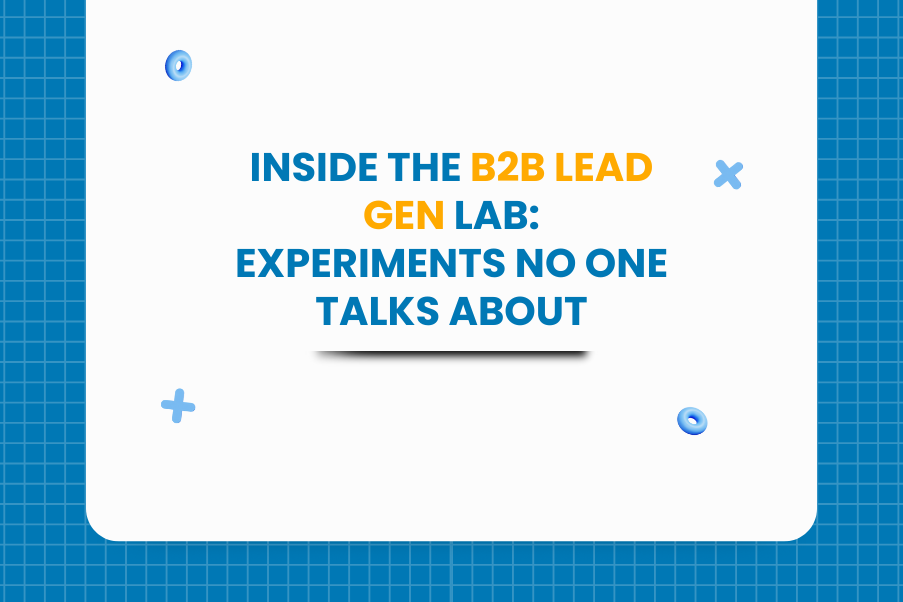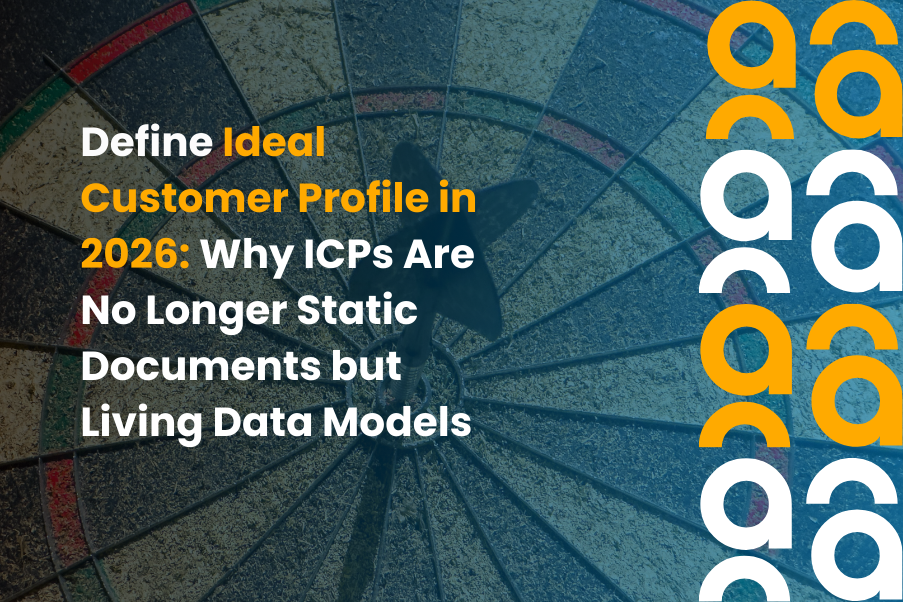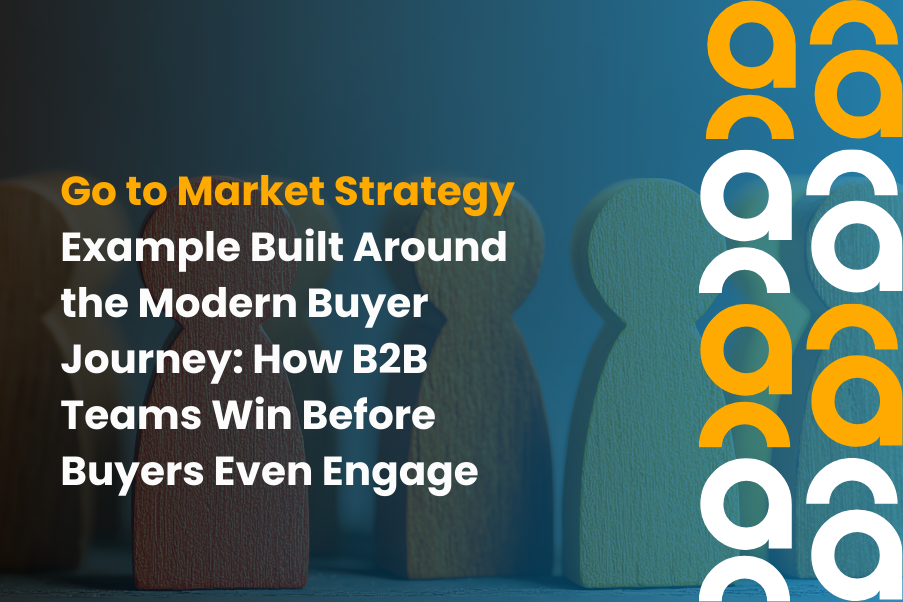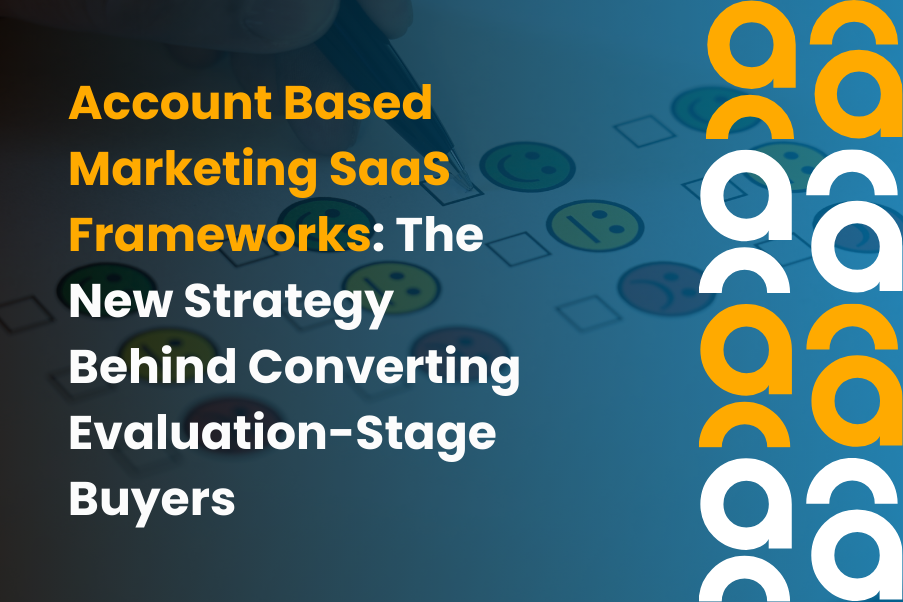Inside the B2B Lead Gen Lab: Experiments No One Talks About

Introduction
Why do some B2B leads respond immediately while others remain unresponsive, even when the offer, ICP, and channels are seemingly perfect? The difference isn’t luck. It’s in the experiments that go behind every interaction. High-performing agencies, especially a top B2B lead generation agency, treat lead generation like a scientific lab. They map response curves, measure decay in buyer intent, test follow-up cadences, and optimize content angles for maximum engagement. Every variable, from timing of outreach to the framing of messaging and the sequencing of triggers, is measured, analyzed, and iterated to understand what actually moves a lead from interest to action.
This blog shows how a top B2B lead generation agency uses data-driven experiments to optimize timing, content, and engagement, turning prospects into qualified opportunities while offering actionable insights for outsourcing, best practices, and lead generation solutions.
Understanding the B2B Lead Gen Lab
The B2B Lead Gen Lab is the experimental engine behind every high-performing campaign run by a top B2B lead generation agency. Unlike traditional outreach that relies on guesswork or one-off strategies, the lab operates like a data-driven testing ground. Agencies systematically experiment with hundreds of variables, including timing, messaging, content formats, engagement triggers, and prospect behaviors, to uncover patterns that drive conversions.
By analyzing behavioral data across thousands of leads, the lab identifies what works for different types of prospects: hot, warm, or cold. It then tailors approaches for various decision-makers. Every test is controlled and measured so small changes can be linked directly to performance outcomes.
The purpose of the lab is twofold. First, to predictably convert passive prospects into qualified opportunities. Second, to create repeatable, scalable strategies that inject consistency into the often unpredictable world of B2B lead generation. Companies leveraging B2B lead generation outsourcing can also benefit from these tested approaches, gaining access to B2B lead generation tips that optimize every interaction.
Experiments That Drive B2B Conversions
See how a top B2B lead generation agency fine-tunes timing, messaging, and engagement to turn interest into real, qualified leads.
Experiment 1: The Timing Experiment
Timing is one of the biggest hidden performance drivers. Inside the lead gen lab, a top B2B lead generation agency tests how speed and spacing impact response and conversion, far beyond the usual “send emails at 10 AM” rule.
Research-backed patterns show how critical timing really is:
- First 60 seconds: Inbound requests convert significantly higher
- First 60 minutes: Response rates peak
- After 24 hours: Intent drops sharply
But the real lift comes from testing long-term follow-up cadence. After the first outreach, agencies experiment with structured spacing: a touch on Day 2, another on Day 4, then Day 7, followed by a message between Day 10 and Day 14. After this sequence, the cadence shifts into a steady check-in every two to three weeks. This mirrors real buying behavior, where most conversions require six to eight follow-ups and nearly half of deals close only after the fifth touch.
Lead type also shapes the timing rules. Hot leads, such as demo requests or pricing-page visitors, convert up to ten times higher when contacted within five minutes. Warm leads, such as webinar attendees or content downloaders, respond best when followed up within one to two hours. Cold leads need more time, trust, and education before they engage.
Ultimately, the timing experiment reveals a clear truth. Timing is contextual, not universal. Warm leads demand speed, cold leads require patience, and Wednesdays and Thursdays consistently emerge as the strongest follow-up days. Applying these B2B lead generation services tips ensures outreach is both timely and effective.
Experiment 2: The Content Angle Experiment
Content is the fuel of any lead gen engine, but inside the lab, agencies don’t just publish content. They test angles.
Effective lead generation content must create impact fast. It must communicate your USP, prove you understand the problem, and earn credibility early. That’s why every format is reframed and tested until it resonates.
Agencies run angle experiments such as:
- Pain-First vs. Value-First Messaging: eBooks, whitepapers, and guides are created in two versions, one focused on the problem and the other on the outcome
- ROI-Led vs. Risk-Avoidance Narratives: “Cost reduction” performs differently than “minimized operational risk”
- Operational vs. Strategic Storytelling: Managers respond to checklists and templates, CXOs prefer reports, insights, and whitepapers
Content format plays a big role too. The lab studies which assets perform best at each stage: eBooks for deep education, tools/templates for instant value, videos for awareness, case studies for trust, landing pages for conversions. None of these choices are random. Experiments reveal which formats different audiences actually prefer. Following these B2B lead generation best practices ensures content resonates with the right decision-makers at the right stage.
Experiment 3: The Engagement Trigger Experiment
Triggers are one of the most overlooked conversion levers. Inside the lead gen lab, agencies study what actually pushes a B2B lead to act, not just the CTA button but the psychology behind the moment of engagement. The goal is simple. Make the action feel safe, relevant, and instantly valuable.
A consistent pattern emerges across experiments. Low-commitment, value-first prompts almost always outperform high-commitment asks. This is why reply-based CTAs like “Want the template?” or “Should I share the audit breakdown?” repeatedly beat “Book a 10-minute call.” They feel lighter, reduce perceived risk, and match the cautious mindset of B2B buyers.
What the Lab Tests:
- Low-Commitment CTAs: Short reply prompts lower friction and feel safe for skeptical buyers
- Micro-Content Offers: Benchmark snapshots, short explainers, checklists, FAQ clips, and mini-guides drive engagement with minimal effort
- Behavior-Based Triggers: Follow-ups tied to actions, such as video views, scroll depth, downloads, and case study reads, lift engagement because messages feel personalized and timely
- Channel-Specific Triggers:
- Email: Best for logic-heavy content, ROI tools, and detailed insights
- LinkedIn: Strongest for social proof, credibility, and peer validation
- SMS: Effective for immediacy and quick nudges
- Website prompts: Win through perfect timing and intent signals
- Email: Best for logic-heavy content, ROI tools, and detailed insights
Together, these insights reveal a simple truth. Engagement happens when content meets the buyer’s mindset. Templates, tools, and short videos engage because they offer instant utility. Case studies resonate because they reduce risk. Benchmarks and ROI snippets attract CXOs who think in numbers. Following these B2B lead generation solutions and B2B lead generation tips consistently improves conversion rates.
The experiment ultimately proves that triggers work best when the action feels effortless and the value is immediate. When psychological alignment, channel choice, and content format come together, passive interest turns into measurable response, predictably and consistently.
Conclusion
The experiments inside a top B2B lead generation agency reveal a simple but powerful truth. Successful lead generation isn’t about luck or guesswork. It’s about understanding what drives behavior and testing relentlessly. From precise timing to content angles and engagement triggers, every variable is measured, optimized, and aligned with buyer psychology.
By embracing this scientific, data-driven approach, a top B2B lead generation agency transforms unpredictable pipelines into consistent, high-performing ones. The insights gained from these experiments allow marketers to convert passive prospects into qualified opportunities, build trust across multiple touchpoints, and engineer repeatable success at scale.
Partner with Almoh Media to turn prospects into loyal customers, boost engagement, and grow your pipeline with strategies that deliver real results.
Introduction
If you’re using content syndication, chances are you see it as just another way to get your content in front of more eyes. That’s fine, but there’s a lot more hidden beneath the surface. When you allow its full potential, content syndication ROI can surprise you, and it doesn’t take much to shift perception.
Let’s look at fresh data, outline a winning content syndication strategy, and show how U.S. B2B teams can get real value from it. Let’s begin!
What Is Content Syndication?
At its simplest, content syndication means sharing your B2B content: whitepapers, case studies, blogs on someone else’s site or network. This can be paid or free. You expand your reach, tap into new networks, and generate visibility, often reaching audiences you’d otherwise miss.
Why ROI From Content Syndication Deserves a Second Look
1. Huge lead production for relatively low spend
According to recent studies, the average cost per lead with content syndication is around $43. That’s far lower than other tactics, so even moderate conversion rates can offer solid returns.
2. Fast pipeline growth
Some platforms report that customers see 300–500% return on investment within three years. That’s not fluff – it’s real pipeline growth.
3. Verified conversion tracking methods
With UTM tagging and targeted vendor reports, U.S. marketers can track everything from initial syndication click to closed deal.
4. Built-in trust and positioning
Syndicating through known sites can give you indirect credibility, boosting brand awareness and authority without extra effort.
B2B Content Syndication Strategy: How to Do It Right
A good content syndication strategy starts long before content hits a third-party platform:
a). Pick assets that matter
Whitepapers, case studies, and long-form guides work best. They not only attract interest but also help establish your brand as industry-relevant.
b). Target lead quality, not rush volume
Instead of chasing clicks, target professionals. For example, top B2B firms average a 5.31% conversion rate on syndication offers.
c). Tag everything with UTM links
Measure traffic, engagement, bounce rates, and conversions back at your URL. This helps with syndication attribution.
d). Track core metrics
- CPL (cost per lead)
- MQL-to-SQL conversion rates
- Revenue per lead (use your average contract value)
e). Use the ROI formula
ROI= Revenue−Spend
Spend
For example, $1,000 spent → 50 high-quality leads → $5,000 average value = ($250k – $1k)/$1k = 249× ROI.
f). Optimize, rinse, repeat
Check what works by audience, site, and format. Then double down and drop what doesn’t.
Concrete U.S. ROI Stats You Can’t Ignore
| Metric | Statistics/Insight |
| Cost per lead | $43 average CPL |
| Syndication conversion rate | ~5.31% typical |
| Lead-to-deal conversion lift | 45% increase when focus is on quality |
| ROI over 3 years | 300%–500% reported |
| Projected industry growth | From $4.7 B in 2022 to $5.9 B by 2030 |
Content Syndication for Lead Gen: A Step‑by‑Step Plan
1. Define your ideal audience
Use buyer personas: titles, sectors, company size – so your content finds the right hands. This way, a sharper audience focus helps eliminate wasted spend and improves downstream lead quality.
2. Pick content with substance
Original research, how-to guides, competitive whitepapers – these both educate and convert. Plus, assets that solve specific problems tend to drive stronger engagement and more intent-driven leads.
3. Choose partners wisely
Use third-party platforms to reach U.S. B2B audiences. Look for those offering clear lead reporting and media kits. Before moving forward, ask for case studies or past performance metrics to make a more informed decision.
4. Structure campaigns with UTM tags
Make distinct tracking links for each partner and asset. This makes sure it’s easier to attribute leads, identify top performers, and compare ROI across channels.
5. Launch and monitor
Track CPL, CPL-to-SQL, cost per opportunity, pipeline driven, and revenue tied. At the same time, monitor activity in real-time to catch early trends and shift strategy fast if needed.
6. Review and refine monthly
Use metrics to shift spend toward top performers and tweak underperformers. As a result, consistent optimization keeps your syndication efforts aligned with revenue goals, not just vanity metrics.
How to Calculate Content Syndication ROI
- Calculate total spend (vendor fees + internal costs).
- Count total leads.
- Multiply leads by average deal size for potential revenue.
- Apply the ROI formula:
Revenue−Spend
Spend - Compare ROI over time to benchmark your initiatives.
This method is backed by multiple calculators and case studies.
Hidden Content Syndication Benefits
- SEO gains: Backlinks from quality sources can raise domain authority.
- Brand authority: Recognition on respected sites = credibility.
- Extended content life: A blog post can live on for months if syndicated well.
- Nurture acceleration: Leads from syndication are often further along in buying cycles.
Mistakes to Avoid and Fix Fast
Mistake: Only tracking clicks, not deals.
Fix: Tie every lead back to conversions with CRM integration. That way, you get a clearer picture of what’s actually driving revenue, not just traffic.
Mistake: Focusing only on cheap volume.
Fix: Go after quality; MQL-to-SQL rates matter most. Otherwise, your sales team will waste time on leads that won’t convert.
Mistake: Publishing irrelevant content.
Fix: Audit content – ensure tone, relevancy, and depth match syndication partner audiences. In doing so, you increase the chances of your content resonating with the right decision-makers.
Mistake: Not optimizing over time.
Fix: Regular performance review. Cut poor performers, boost winners. Over time, this helps improve ROI and keeps your content syndication strategy focused and results-driven.
Why Lead Quality Beats Volume
Not all leads are created equal. A smaller batch of high-intent leads can drive more revenue than a huge pool of low-interest ones.
Many B2B brands in the USA are shifting toward account- based syndication, where campaigns are matched to specific industries or companies. This helps improve conversion rates, shorten sales cycles, and increase customer lifetime value.
In short, prioritizing lead quality helps improve the long-term content syndication ROI, especially when targeting high-ticket accounts.
How AI Is Shaping the Future of Syndication
AI tools are starting to reshape content syndication strategy by analyzing behavior patterns and automating placements across high-performing channels.
With predictive scoring, marketers can now:
- Match content formats to individual user segments
- Forecast lead readiness using engagement scores
- Automate syndication at scale using content intent data
These innovations are raising the ceiling on what’s possible for B2B content syndication, especially for companies focused on measurable results.
About Almoh Media
Use metrics to shift spend toward top performers and tweak underperformers.
As a result, consistent optimization keeps your syndication efforts aligned with revenue goals, not just vanity metrics.
At Almoh Media, we specialize in high-impact content syndication for lead gen. We help B2B companies in the U.S. grow their pipelines by delivering:
- Verified lead generation from trusted channels
- Industry-specific targeting and campaign setup
- Transparent reporting tied to your sales funnel
- A proven strategy backed by real ROI
We understand the U.S. B2B buyer journey, and our syndication campaigns are built to generate demand, not just clicks.
Final Takeaway
Content syndication is an easy win if done smartly.
Focus on:
- Quality, not just volume
- Clear tracking and attribution
- Lead-to-deal conversions
- Continuous optimization
With $43 CPL, 5+ percent conversion, and long-term returns of 300–500%, most U.S. B2B teams can justify putting more budget behind it.
Ready to Get Real ROI from Content Syndication?
Let Almoh Media help you build a smarter lead-gen machine. We bring strategy, scale, and precision to content syndication – so your campaigns don’t just get seen; they convert. Reach out now to get started.
-
 Define Ideal Customer Profile in 2026: Why ICPs Are No Longer Static Documents but Living Data Models
Define Ideal Customer Profile in 2026: Why ICPs Are No Longer Static Documents but Living Data Models -
 Go to Market Strategy Example Built Around the Modern Buyer Journey: How B2B Teams Win Before Buyers Even Engage
Go to Market Strategy Example Built Around the Modern Buyer Journey: How B2B Teams Win Before Buyers Even Engage -
 Account Based Marketing SaaS Frameworks: The New Strategy Behind Converting Evaluation-Stage Buyers
Account Based Marketing SaaS Frameworks: The New Strategy Behind Converting Evaluation-Stage Buyers -
 What 2026’s Best-Performing Teams Do Differently when it comes to B2B Account-Based Marketing Campaigns
What 2026’s Best-Performing Teams Do Differently when it comes to B2B Account-Based Marketing Campaigns -
 B2B Account Based Marketing in an Over-Messaged World: The Rise of Context-First Personalization
B2B Account Based Marketing in an Over-Messaged World: The Rise of Context-First Personalization

